Monstera Albo, a popular houseplant known for its stunning leaves, can sometimes face the issue of browning leaves. This can create concern and frustration for plant owners, as they try to figure out the underlying causes of the problem and find solutions to help their beloved plant. In this article, we will explore the potential reasons for browning Monstera Albo leaves and provide practical advice on how to address them.
Browning leaves on a Monstera Albo can be attributed to various factors, ranging from environmental conditions to plant care practices. Identifying the root cause is essential for preventing further damage and restoring the plant’s health. By familiarizing yourself with the signs and symptoms, as well as the preventative measures and treatment options, you can ensure that your Monstera Albo remains healthy and vibrant.
Key Takeaways:
- Environmental factors, such as improper light and temperature, can cause browning in Monstera Albo leaves.
- Watering habits and humidity levels are crucial in maintaining the health of your Monstera Albo.
- Diagnosing the problem and implementing appropriate treatment options will help restore your plant’s natural beauty.
Signs and Symptoms of a Browning Monstera Albo
As a Monstera Albo owner, you should be aware of the various signs and symptoms of your plant experiencing browning issues. Browning can be a result of different factors, but being observant and knowledgeable about these signs will help you address any potential problems early.
One of the first signs of a browning Monstera Albo is the appearance of brown spots on the leaves. These spots can vary in size and shape but typically begin small and may expand over time if left unaddressed. Pay close attention to the transition of these brown spots as they may indicate the underlying cause of the issue.
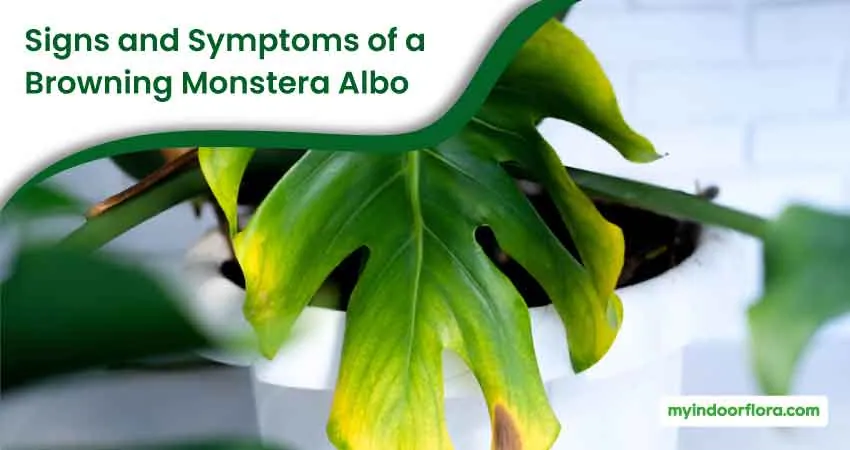
Another sign of browning in your Monstera Albo is a change in leaf texture. Healthy Monstera leaves should be firm and moist. If you notice the leaves becoming dry or brittle, this could be an early warning sign of browning. Similarly, if the leaves appear limp or wilting, it may also indicate that the plant needs attention.
Yellow leaves combined with brown spots on Monstera leaves are a symptom that should not be ignored. Yellowing leaves can point to improper watering, stress on the plant, or even root rot, all of which may lead to browning. Keep an eye on the overall health and color of your Monstera Albo’s leaves, as a combination of yellowing and brown spots can indicate more severe problems.
Moving forward, be sure to regularly monitor your Monstera Albo for any changes in leaf color, texture, or the appearance of dry spots. By staying vigilant and providing proper care, you can maintain a healthy and thriving Monstera Albo.
Fundamental Causes of Browning
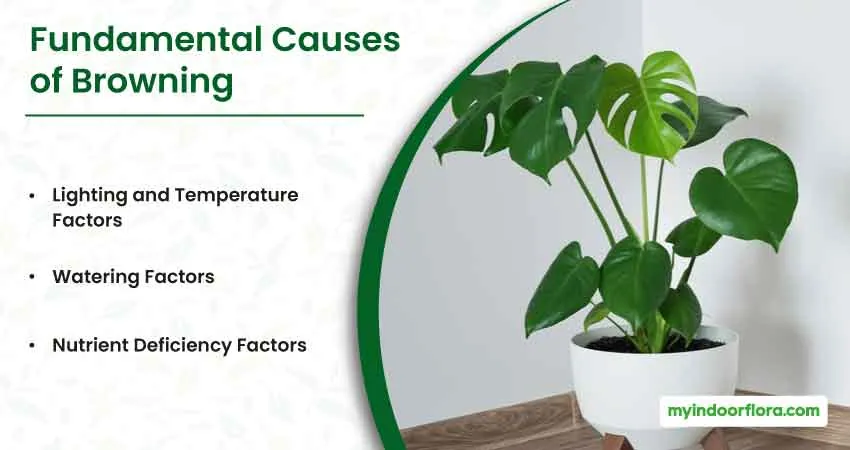
Lighting and Temperature Factors
Your Monstera Albo might be turning brown due to lighting and temperature factors. Insufficient light or too much sunlight can cause browning. Make sure to place your plant in a spot with bright indirect light. Direct sunlight can cause sunburn on the leaves, leading to brown spots.
Temperature stress can also contribute to browning. Monstera Albo prefers temperatures between 65°F and 85°F (18°C – 29°C). Cold temperatures and drafts can cause browning on the leaves. Ensure your plant is away from cold drafts, such as air conditioning vents or open windows during winter months.
Watering Factors
Improper watering is another common cause of browning in Monstera Albo plants. Both overwatering and underwatering can lead to brown leaves. Your Monstera Albo likes its soil to be consistently moist but not waterlogged. To achieve this:
- Water your plant when the top 2-3 inches of soil feel dry to the touch.
- Ensure the pot has adequate drainage to prevent root rot.
Low humidity can also cause browning on Monstera Albo leaves. This plant thrives in humidity levels of 60% or more. To increase humidity, you can:
- Place a tray filled with water and pebbles underneath the pot, ensuring the pot doesn’t touch the water.
- Use a humidifier in the room where the plant is located.
Remember that dry air from heating and air conditioning systems can affect the humidity levels around your Monstera Albo, so adjusting the humidity is crucial for its wellbeing.
Nutrient Deficiency Factors
Browning on Monstera Albo leaves can also be attributed to nutrient deficiencies or imbalances. These plants require adequate amounts of nitrogen, phosphorus, and potassium, as well as trace elements. Lack of proper nutrients or over-fertilization can lead to browning.
To avoid nutrient-related issues:
- Use a well-balanced fertilizer to provide your Monstera Albo with essential nutrients.
- Follow the manufacturer’s guidelines regarding dosage and application frequency.
- Be cautious of potential fertilizer burn, which can cause brown spots on the leaves. If you suspect this issue, flush your plant’s soil with clean water to remove excess nutrients.
By addressing these lighting, temperature, watering, and nutrient factors, you can prevent your Monstera Albo from turning brown and help it thrive in a healthy environment.
Less Common Causes of Browning in Monstera Albo
Apart from the typical causes of browning in Monstera Albo, such as over-watering, under-watering and excessive sunlight, there are a few less common factors that could also be affecting your plant. In this section, we will discuss the potential impact of humidity, pests and diseases, and soil quality on your Monstera Albo.
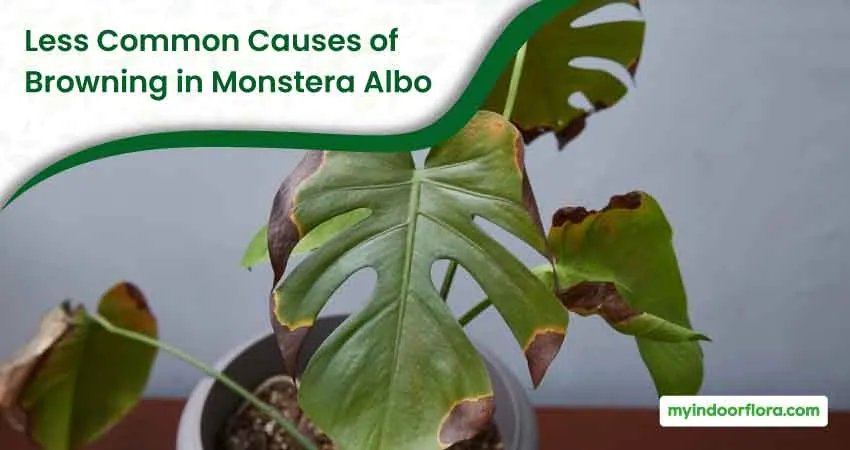
Humidity
Monsteras thrive in a humid environment, as they originate from tropical rainforests. If the humidity level in your space is too low, it might cause the leaves to turn brown. To improve humidity, you can:
- Use a humidifier in the room with your plant.
- Place a tray of water near the plant. As the water evaporates, it increases the humidity around the plant.
- Regularly mist your plant’s leaves with water.
Pests and Diseases
Pests and diseases can also lead to browning of Monstera Albo leaves. Common pests affecting Monstera plants include mealybugs, spider mites, and scale insects. Here are some tips to keep pests under control:
- Inspect your plant regularly for signs of pests and treat infestations promptly.
- Use natural remedies, like neem oil or insecticidal soap, to treat and prevent pest infestations.
- Quarantine any new plants before introducing them to your plant collection to prevent the spread of pests.
Diseases such as root rot and bacterial or fungal infections can also cause browning in Monstera Albo. To prevent diseases:
- Ensure proper watering techniques to avoid over-watering, preventing root rot.
- Keep your plant clean and tidy by regularly removing any dead or decaying leaves.
- Provide adequate air circulation around your plant to prevent the spread of infection.
Soil Quality
Lastly, the quality of the soil you’re using could be another less common factor contributing to browning in your Monstera Albo. Monsteras require well-draining soil to thrive. A chunky aroid mix works well, as does LECA (Lightweight Expanded Clay Aggregate). Ensure that your plant is not in plain potting soil, as this may retain excess moisture and lead to root rot or other issues.
Remember, maintaining proper care and being diligent with your Monstera Albo will help prevent these less common factors from causing browning and keep your plant healthy and vibrant.
Diagnosing the Problem: Steps to Determine the Cause
So, you’ve noticed your Monstera Albo turning brown and you’re eager to figure out what’s wrong. Fear not! In this section, we will guide you through a systematic approach to diagnose the problem and help your Monstera Albo get back on track.
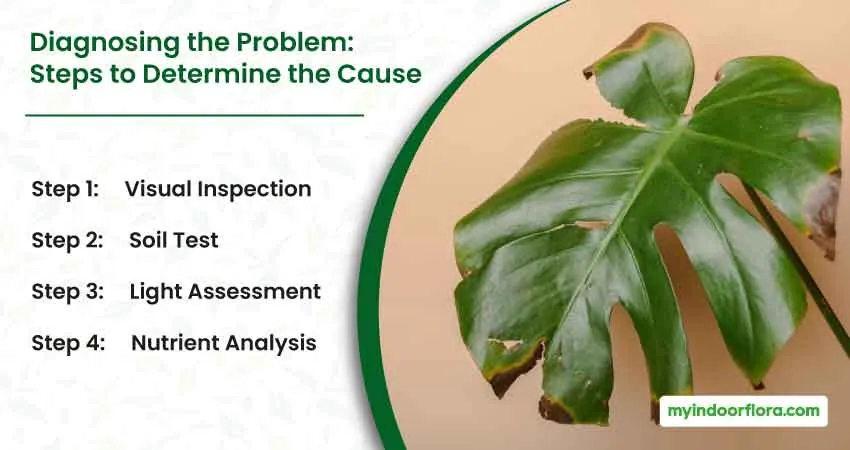
Step 1: Visual Inspection
Begin by closely examining your plant, paying special attention to the leaves, stems, and visible roots.
- Leaves: Check for any spots, discoloration, or dry areas.
- Stems: Inspect them and look for signs of rot or discoloration.
- Roots: If possible, gently remove the plant from its pot and check the roots for any signs of rot.
Step 2: Soil Test
Perform a simple test to gather information about the moisture and nutrient content of the soil.
- Moisture Level: Insert your finger into the soil up to one inch. Wet soil can indicate overwatering.
- Nutrient Test: Use a soil testing kit to determine if your plant is lacking any essential nutrients.
Step 3: Light Assessment
To ensure your plant is receiving adequate light, either too little or too much, assess the amount of light that your Monstera Albo is exposed to.
- Light Meter: Invest in a light meter to obtain exact measurements.
- Mobile Apps: Use mobile apps that can give a good approximation of light conditions.
Step 4: Nutrient Analysis
Consider sending a soil sample for professional nutrient analysis. This service provides an in-depth report of the nutrients in your soil, helping you identify any deficiencies.
- Macro Nutrients: Nitrogen (N), Phosphorus (P), Potassium (K)
- Micro Nutrients: Calcium (Ca), Magnesium (Mg), Sulfur (S)
Taking a structured approach to diagnose the issue
Treatment Options for Browning Monstera Albo
Once you have identified the cause of your Monstera Albo’s browning, it’s essential to act quickly to treat the issue. Here are some steps you can take to help your plant recover.
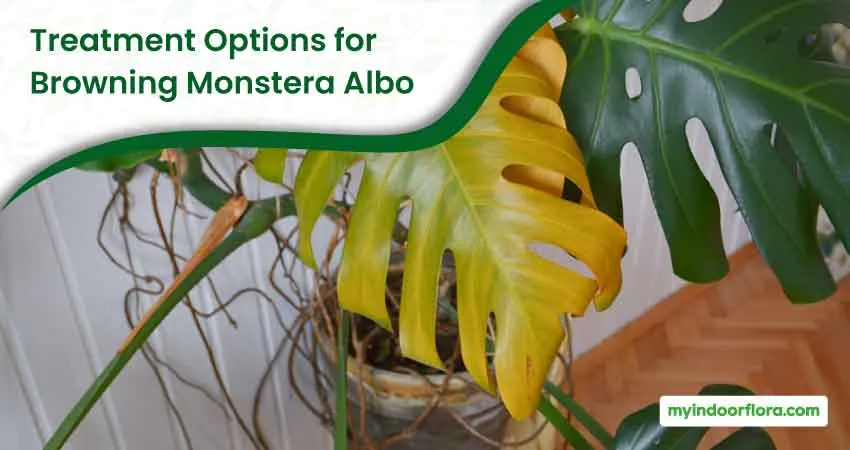
- Immediate Interventions: Acting fast is crucial when dealing with a sick plant. Make sure to trim off all the brown parts of the leaves to prevent further decay. If you find that improper watering is the issue, adjust your watering schedule as soon as possible.
- When to Consider Repotting: Keep an eye out for signs of root rot or excessive salt buildup in the soil. If you observe any of these issues, it’s best to repot your plant to provide it with fresh soil and a healthy environment for root growth. In addition to these steps, long-term care strategies are essential for maintaining your Monstera Albo’s health. Consistency is key when nurturing your plant back to full health.
- Scheduled Watering and Feeding: Develop a watering schedule based on the Monstera’s needs during different seasons. Generally, your plant will require less frequent watering in cooler months. Fertilizing your plant every 6-8 weeks with a balanced fertilizer will also promote steady growth and overall health.
- Ongoing Light and Humidity Management: Monitoring the light and humidity around your Monstera Albo is crucial in keeping it healthy. Use a humidity meter to ensure optimal humidity levels and consider investing in a grow light to provide consistent light conditions if necessary.
Preventive Measures to Keep Your Monstera Albo Healthy
Effective Watering Practice
To prevent your Monstera Albo from turning brown, it’s important to establish an effective watering practice. Monstera plants thrive in moist soil, but they don’t like being over-watered. Signs of overwatered Monstera include yellow leaves with a yellow halo surrounding the brown spots. Allow the top inch of your plant’s soil to dry out before watering it again. Be sure to use well-draining soil and avoid letting your plant sit in water-filled saucers or pebble trays to prevent root rot.
Optimizing Light and Temperature
Proper lighting is crucial for Monstera Albo’s health. Provide your plant with bright, indirect sunlight to maintain its vibrant variegation. Place your Monstera near a window, where it can receive at least six to seven hours of filtered light daily. Keep in mind that too much direct sunlight can cause the variegated parts of the leaves to sunburn. Also, maintain a suitable temperature range between 65°F and 85°F for your tropical plant to flourish.
Humidity Management
Monstera plants originate from tropical rainforests, making them humidity-loving plants. Maintain a humidity level between 60% and 85% for optimal growth. You can achieve this by:
- Misting the leaves frequently with distilled water. Avoid using tap water to prevent unwanted minerals from depositing on the leaves.
- Placing a pebble tray filled with water beneath your plant.
- Grouping humidity-loving plants together.
- Using a humidifier in the room hosting your Monstera Albo.
Nutrition and Fertilization
Providing adequate nutrition is essential to keep your Monstera Albo healthy. Fertilize your plant every four to six weeks during its growing season, from spring to early fall. Use a balanced, water-soluble fertilizer, and always follow the package directions to avoid over-fertilization, which can lead to nutrient deficiencies and brown leaves.
Regularly check your plant for any damaged or diseased leaves and prune them as needed. Inspect the aerial roots, too, as they should remain healthy and green, indicating that your Monstera is receiving enough chlorophyll and nutrients. By taking these preventive measures, you can keep your Monstera Albo healthy and protect it from developing brown leaves.
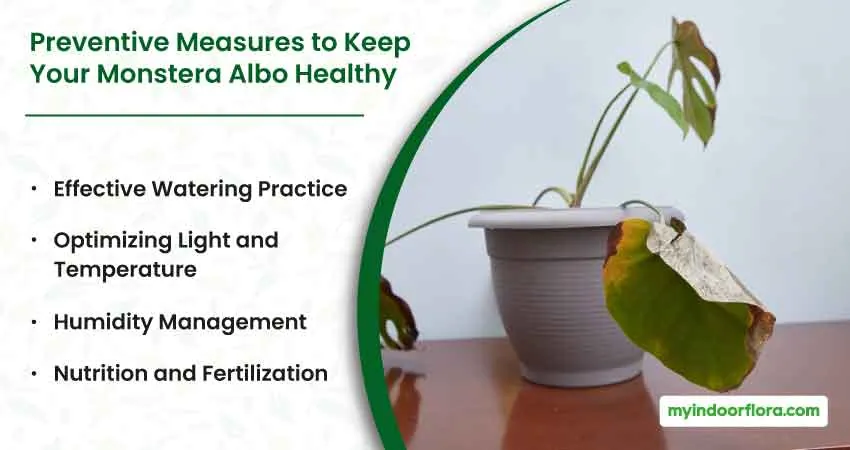
In summary,
browning Monstera Albo leaves can be a cause for concern, but understanding the key factors—such as lighting, temperature, and watering practices—can help you take corrective action. Regular monitoring and preventive care will ensure your Monstera Albo stays healthy and vibrant.
